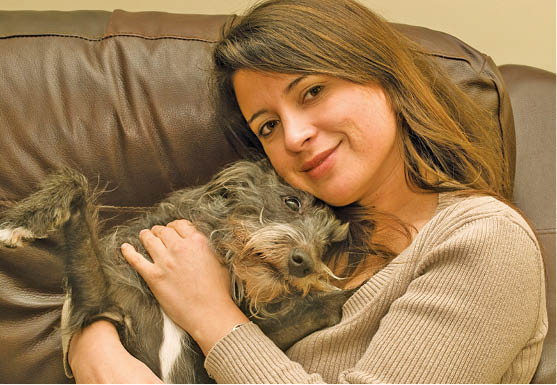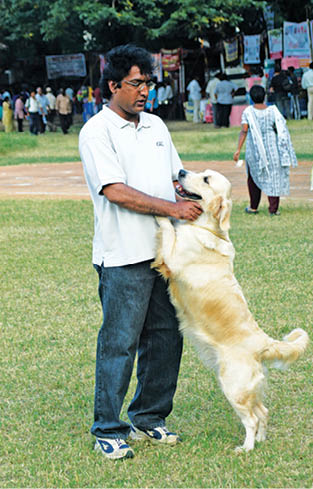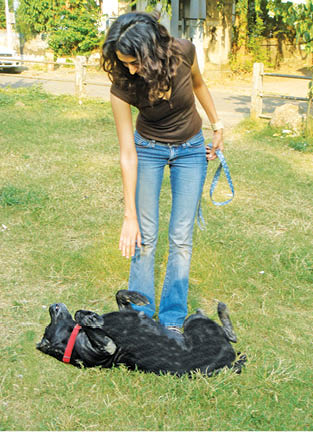“Bruno… Come here… BRUNO! NOW!” you shout as your pooch walks slowly towards you, detouring to cock a leg at a few bushes on the way. You wait impatiently for him to hurry back to you. “BRUNO!” …you’re getting increasingly angrier! He knows his command, and is being stubborn, you think. Wait till he gets back to you, he’s going to get it!
…But wait. Before you punish your dog for what you think is insolence, have you ever looked at the situation from his point of view? The truth is your dog is not being obstinate, nor is he rebelling, he is just uncomfortable with the situation and even though you may be calling out to him, your body language communicates your anger and keeps him at bay. Walking slowly towards you helps ease his stress, and he hopes the slow movement will calm you down too!
Amazing? Yes, but also true. Like any other pack animal, dogs have to learn to communicate without the benefit of a language; and though canine communication consists of many woofs and wags, dogs prefer to rely more on subtle body language cues – a raised eyebrow, a frown or even a stare – to gauge what the other person or dog is saying.
When communicating with our dogs, many of us continually use mixed cues to get a message across. Most often, dogs usually read our signals correctly. But sometimes, a dog gets perplexed if he receives conflicting messages. The constant presentation of unclear and confusing messages to a dog will make him anxious, bewildered, and less likely to obey; and, in certain cases, result in a bite.
Truth is, it is our responsibility to make an effort to communicate clearly to our dogs. Learning how human behaviour affects canine behaviour can bring out the best in our canine companions and in our relationships with them. Here are a few of the common mistakes we make when interacting with dogs.
TRAINING TIPS:
People who think training a dog is about domination and force have got it all wrong. Training is actually a two-way communication between man and dog, and aggression has no part to play in it. For best results when training, be your dog’s best friend and partner – not his boss. Go over our tips below to see where you could be making a mistake. Alter the way you train, and see an amazing change in your pet.
Your pet will learn better if you appreciates them, as a dog responds both to physical and verbal cues. We are often consistent with our verbal cues (“Sit, “Stay”, “Come”), but we keep changing our physical cues (the way we stand, gesture or facial expressions), often confusing our pets. While most dogs can read our signals correctly, a bit of consistency on our part can make a world of a difference to your dog’s obedience.
Help by being less demanding and thus making the dog feel more comfortable. A dog that is stressed by an angry or tense trainer is too scared to obey.
Avoid shouting the command at your dog, shouting won’t make a dog obey better or faster. It has no training value whatsoever. A good trainer always gives a command in a firm and even tone.
NEVER EVER HIT a dog for disobeying – not only does it hurt, but the pain causes your dog to fear you and get put off with the training. Over a period of time, the dog loses trust in you because he connects the owner to the pain. With kinder methods of training now prevalent, hitting is a thing of the past.
How To Make Your Dog Sit:
RIGHT WAY: The easiest and quickest way to get a dog to sit, is to use biomechanics. To do that, stand in front of him with a food treat in your hand. Hold the treat in front of his nose and gently move your hand backwards. As his head tilts backwards, he will be forced to sit to maintain his balance. To prevent him from shuffling or walking back, practise the command with his hind end touching a wall – as he backs into it, he will automatically sit.
WRONG: When luring a dog to follow a sit command, make sure your hand is just above the dog’s nose. If it is too high, no matter what the command, the dog will jump instead of sitting. Remember, your dog is following your physical cues more than your verbal ones.
When training the dog to sit or lie down make sure you do not bend or ‘loom’ over the animal. Dogs hate being loomed over and will instinctively move away from you, making it difficult to continue the training. Try instead, to bend from the knees.
Down Boy!
RIGHT: The friendliest way to teach a ‘down’ is by luring the dog into position. First get your dog into a sitting position. Hold a treat in your hand and lure his head downward till he is bent over, then move your hand forward till he goes into the down position to get to the treat. Reward him with your hand close to the floor.
WRONG: When you loom over the dog, he will likely roll over on his back. It is not that he is disobeying you, but is showing you a submissive posture in deference to your dominant body language. To correct the problem, straighten up, bend from the knees or stand to the side of the animal to get better results.
Many people attempt to train a dog to go into a down or a sit by pushing on their hind ends. Instinctively, most dogs will push up or in the opposite direction of the push, which means they will remain standing. Thus our body language tells the dog to remain standing, even though we may ask it to sit or lie down.
 Recall:
Recall:
WRONG: People often call their dogs by bending over and slapping the thigh – a posture most dogs view as aggressive. Do not stoop towards a dog coming to you. If you do, in most cases he won’t come all the way up to you but will run past you looking away. Instead, stand upright with your side towards the dog.
RIGHT: Turn and walk away or turn your body sideways or even crouch and your dog will come much more willingly towards you. Never threaten your dog to come to you, it rarely works, instead use and excited, happy voice and watch him come bounding in to you.
Leash Walking:
 WRONG: Do not jerk the leash or drag the dog when teaching a dog to heel. It causes the animal to resist the pain and pressure by leaning in the opposite direction.
WRONG: Do not jerk the leash or drag the dog when teaching a dog to heel. It causes the animal to resist the pain and pressure by leaning in the opposite direction.
RIGHT: Instead, try and keep the leash slack and use your voice and tasty treats to encourage your dog to be by your side.
Mixed Signals:

Hugging:
Humans express affection by hugging, but should keep in mind that hugging is a primate behaviour. Canines do not view a hug as a gesture of affection. While most dogs learn to accept being hugged, people who do it with strange dogs are putting themselves at risk.
Jumping Up:
 WRONG: Nobody likes a dog that jumps on them. But no matter how much we may scold the dog or shout, our body language of pushing him away and backing up, is interpreted by the dog as an invitation to play.
WRONG: Nobody likes a dog that jumps on them. But no matter how much we may scold the dog or shout, our body language of pushing him away and backing up, is interpreted by the dog as an invitation to play.
RIGHT: Turn your back on the dog and ignore the behaviour and then reward an alternate, acceptable behaviour, such as a sit.
Say Hello Respectfully:
 Would you ever walk up to a stranger on the street and touch the person? Probably not, yet that is how we greet strange dogs. We walk right up to the dog and touch it. Whilst many of them might accept it, a dog that is sensitive or frightened, will retaliate by biting or snapping. In our effort to be friendly, we often end up greeting strange dogs in a manner they consider offensive. A small change in your body language can go a long way in communicating to the dog that you mean no harm.
Would you ever walk up to a stranger on the street and touch the person? Probably not, yet that is how we greet strange dogs. We walk right up to the dog and touch it. Whilst many of them might accept it, a dog that is sensitive or frightened, will retaliate by biting or snapping. In our effort to be friendly, we often end up greeting strange dogs in a manner they consider offensive. A small change in your body language can go a long way in communicating to the dog that you mean no harm.
RIGHT: The next time you greet a dog, try standing sideways and let the dog approach you. If the dog seems uncomfortable, avoid making direct eye contact. If the dog is relaxed, allow him to sniff the back of your hand, then scratch him under the chin or on the chest. Avoid patting a strange, uncomfortable dog on the head as dogs view it as a dominant gesture.
WRONG: Avoid approaching a dog head on. A direct, full frontal approach is a confident, semi-challenging one from dog to dog or person to dog. Also, you should never walk directly toward a dog that is fearful of people, as your sudden approach will likely be viewed as threatening, even if your words and intentions are entirely honourable. A fearful dog should always be approached indirectly from the side.
Keep in mind that fearful dogs are less afraid of people who are sitting down because they feel less threatened. Sitting down on the floor can cause an anxious dog to approach you, whereas standing in front of the dog may be interpreted as a threatening gesture which may put off the dog.
With the right body language and verbal commands given in the right tone, you will see an amazing difference in your dog’s response and obedience.
- The Secret Life Of Dogs: What’s Your Doggie Really Thinking? - 15 March2025
- Cracking The Canine Contentment Code: What Makes Dogs Happy - 10 August2024
- The Dark Side Of Pampered Pets: Is Your Kindness Harming Your Dog? - 16 March2024
